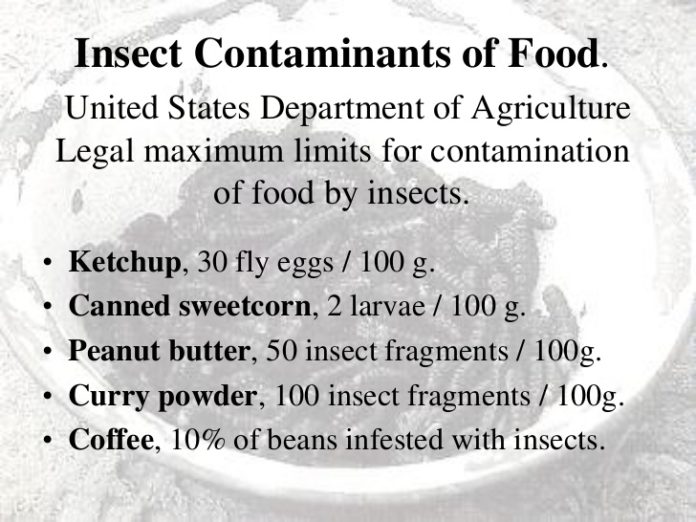Avoid processed and pre-made foods from Edom, especially when it has been canned, ground up or puréed, into a new form. Most likely that food is unclean without you knowing it (now you do know) and in much greater volumes than the employees/owners of a corporation will admit. Hence the prophecy of Ezekiel about our captivity:
- Deuteronomy 14:19 | And every creeping thing that flieth is unclean unto you: they shall not be eaten.
- Ezekiel 4:13 | And the LORD said, Even thus shall the children of Israel eat their defiled bread among the Gentiles, whither I will drive them.
- Ecclesiasticus 12:10 | Never trust thine enemy: for like as iron rusteth, so is his wickedness.
ARTICLE: Kelly Ripa BUGS NATION After Revealing LARGE Amount Of INSECTS Allowed In Food
- Americans eat, on average, “two pounds of flies, maggots and other bugs each year,” according to a Scientific American blog.
Pasta may contain an average of 225 insect fragments.
A cup of raisins can have up to 33 fruit fly eggs.
Fig paste is allowed to have up to 13 insect heads in 100 grams.
Up to five fruit flies is allowed in an 8-ounce cup of canned fruit juice.
One maggot is allowed in every 250 milliliters of fruit.
Up to 2,500 aphids are allowed in every 10 grams of hops.
Spinach can have up to 50 aphids, thrips or mites per 100 grams.
Broccoli can contain insects fragments and even whole insects.
Up to a kilogram of insect parts is allowed in 100 kilograms of chocolate.
Up to 19 maggots and 74 mites are allowed in a 3.5-ounce can of mushrooms.
Up to 15 fruit fly eggs are allowed in 100 grams of tomato sauce.
More than 40 thrips are allowed in 100 grams of asparagus.
Hops used in brewing beer can contain more than 2,500 aphids in 10 grams.
ARTICLE: 13 Common Foods That Could Secretly Contain Insects
- “You eat an average of one to two pounds of flies, maggots, and other bugs each year without even knowing it, according to the Scientific American blog. But don’t panic—they are perfectly safe to consume. In fact, the Food and Drug Administration (FDA) actually permits a small number of insects in food products, because it would be impossible to filter them all out. Read on to learn just a handful of the 100 products that secretly contain insects. (Hint: You probably have most of them in your kitchen right now!)”
ARTICLE: Here’s How Many Insect Parts Are Allowed In Your Food
- “One example given by North Carolina State University agricultural and human sciences professor Ben Chapman, interviewed by CNN Health, was that of a buggy bag of cranberries: it can’t be sold as-is, but could be turned into cranberry sauce where the excess bug bits could be skimmed off the top during the cooking process.”
ARTICLE: Bugs, rodent hair and poop: How much is legally allowed in the food you eat every day?
- CNN, an extension of the male witch covens aka intelligence agencies of the United States treats it as a joke on the general populace they work their witchcraft on:
- “Brace yourselves, America: Many of your favorite foods may contain bits and pieces of creatures that you probably didn’t know were there. How about some rodent dung in your coffee? Maggots in your pizza sauce? Mold in the jelly on your toast? Oh, and so sorry, chocolate lovers. That dark, delicious bar you devoured might contain 30 or more insect parts and a sprinkling of rodent hair. Called “food defects,” these dismembered creatures and their excrement are the unfortunate byproduct of growing and harvesting food. “It is economically impractical to grow, harvest, or process raw products that are totally free of non-hazardous, naturally occurring, unavoidable defects,” says the US Food and Drug Administration. “
Breakfast cereals & breakfast bars are not on this list but that is another big one.
13 Common Foods That Could Secretly Contain Insects
Brooke Nelson Updated: Dec. 09, 2022
If the thought of eating bugs makes you squirm, we have some bad news: You have probably been chowing down on these many-legged creatures for a long time.
1 / 14
Mealworms are the larval form of the mealworm beetle, Tenebrio molitor, a species of darkling beetle pest of grain and grain products as well as home products, on buckwheatTomasz Klejdysz/Shutterstock
Insects in my food? Say what?!
You eat an average of one to two pounds of flies, maggots, and other bugs each year without even knowing it, according to the Scientific American blog. But don’t panic—they are perfectly safe to consume. In fact, the Food and Drug Administration (FDA) actually permits a small number of insects in food products, because it would be impossible to filter them all out. Read on to learn just a handful of the 100 products that secretly contain insects. (Hint: You probably have most of them in your kitchen right now!)
2 / 14
Peanut ButterBarnaby Chambers/Shutterstock
Peanut butter
The 16-ounce jar of peanut butter in your pantry can contain up to 136 insect parts before it is deemed contaminated, according to the FDA’s Food Defect Action Levels guide. This may sound bizarre, but it’s not uncommon for insect fragments—including their heads, bodies, and legs—to accidentally end up in the food we eat. Bugs are constantly present during the food manufacturing process, from the field where the food is grown to the storage and transit of the food to your grocery store. Grossed out yet? Here are more disgusting things you didn’t know were in your food.
3 / 14
Stack of chocolate pieces, close upVolodymyr Krasyuk/Shutterstock
Chocolate
By the FDA’s standards, the average 4.4-ounce chocolate bar may have up to 74 insect fragments. That means chocolate lovers could be adding nearly 6,000 pieces of bugs to their diets each year, according to a recent study by Terro, an ant and insect control company. But wait, there’s more: Cockroach parts are among the most common contaminants found in chocolate, Terro says.
4 / 14
Macro closeup background texture of whole wheat rigatoni pastaEnlightened Media/Shutterstock
Pasta
The FDA legally allows up to 225 insect fragments per 225 grams of pasta before they ban the product from grocery store shelves. In case you didn’t do the math, that’s around one bug bit for each gram of pasta. Insects usually find their way into pasta through wheat, which can contain up to 75 insect parts per 50 grams (about ¼ cup).
5 / 14
Roasted coffee beans backgroundDa-ga/Shutterstock
Coffee beans
Brewers, beware: As you sip on that steaming-hot cup of coffee, you might also be drinking around 120 insect parts. The FDA approves coffee samples that are less than 10 percent insect-infested. At that rate, the average coffee drinker could unknowingly consume almost 140,000 insect fragments per year, according to Terro.
6 / 14
Raisins as background Grape Raisin texture.Nalaphotos/Shutterstock
Raisins
Just one cup of raisins can have up to 35 fruit fly eggs and ten whole insects, per FDA guidelines. Luckily, these critters won’t do any harm to your health. The FDA “allows for a small amount of insect material that is guaranteed safe for human consumption to pass into our food,” Terro writes. “Otherwise, resource costs would be too unmanageable to eliminate all defects from food production.”
7 / 14
mushroomscristi180884/Shutterstock
Mushrooms
If a 3.5-ounce can of mushrooms contains 19 maggots and 74 mites, it is technically FDA-approved. While it might be gross to imagine chowing down on baby bugs, the fragments are so small that you likely won’t even realize they are there. Plus, there is a lot of nutritional value in these insects. Mealworms, another form of insect larva, provide more protein than chicken or salmon, according to Terro’s research.
8 / 14
Collection backgrounds from a different foodstuffSergey Chirkov/Shutterstock
Frozen broccoli
Aphids are tiny bugs—they grow to just 2 to 5 millimeters in size—but they make up about 10 percent of the world’s consumed insects. Aphids are also “notorious for infesting” gardens and crop fields that grow produce like broccoli, Terro writes. The FDA allows up to 60 of these creatures per 100 grams of frozen broccoli. If you eat frozen broccoli regularly, Terro estimates you could be unintentionally eating over 1,600 aphids every year.
9 / 14
a top view of opened can of diced tomatoes on white tableZoeytoja/Shutterstock
Canned tomatoes
A 14.5-ounce can of tomatoes must have more than 8 fly eggs or one maggot before the FDA considers it tainted. But you can rest assured that it’s not out of the ordinary to dine on insect eggs. In fact, they are one of the most common menu items in Mexico. Ahuahutle, also called Mexican caviar, is a local delicacy made with eggs of aquatic insects. Find out more bizarre foods you won’t believe people actually eat.
10 / 14
Macro orange juice can be used for backgroundBeautiful landscape/Shutterstock
Fruit juice
Under FDA rules, canned fruit juices can safely contain pieces of one maggot for every 250-milliliter sample. Everything from snails to mites enjoys feasting on fruit juice, too, and may wind up in your next beverage. While the idea of gulping down bugs might trigger your gag reflex, you shouldn’t feel pressured to pass on a morning glass of OJ. Insects are just a “part of the normal process of growing and processing food,” LiveScience writes.
11 / 14
Ground black pepper backgroundkariphoto/Shutterstock
Ground pepper
Salt and pepper are considered the yin and yang of condiments—and most of us season our food generously with both. But those days might soon be behind you. Believe it or not, up to 475 bug parts can end up in 50 grams (or ¼ cup) of ground pepper and still be considered safe to eat. That is a lot of insect heads and legs spicing up your meal.
12 / 14
cinnamonGayvoronskaya_Yana/Shutterstock
Cinnamon
Cinnamon may work magic when it comes to slimming down your waistline, but it also harbors a big secret. The FDA allows up to 400 insect fragments per 50 grams (or ¼ cup) of cinnamon, their guidelines show. Although that shouldn’t cause you to skip the spice altogether, just keep in mind that those snickerdoodle cookies are not exactly vegetarian.
13 / 14
Close up image of sauerkrautDan Kosmayer/Shutterstock
Sauerkraut
You already know to be wary of hot dogs, whose cellulose-lined tubes are stuffed with mystery meat. But you deserve a heads-up before piling on the condiments, too. Just a few helpings of sauerkraut could contain up to 50 small, stick-like critters called thrips, according to FDA guidelines. Learn more unbelievable food facts that will change how you eat.
14 / 14
Blueberry.Billion Photos/Shutterstock
Berries
Raspberries and blueberries make sweet treats for insects like worms and beetles. Knowing this, the FDA allows up to four larvae or ten whole insects per 500 grams of berries, or about 2.5 cups. Translation? Don’t be surprised if these critters end up in your canned or frozen berries. Odds are, they will be too small to notice.

